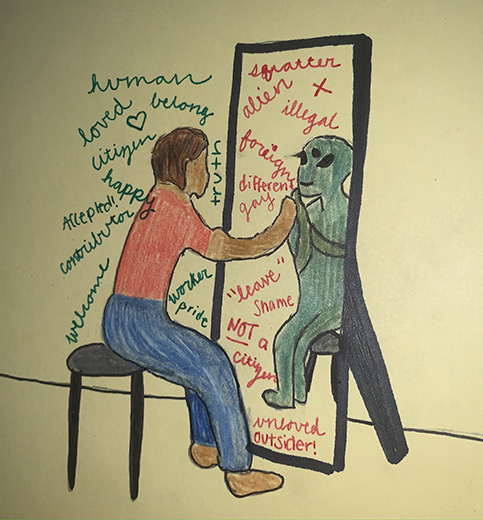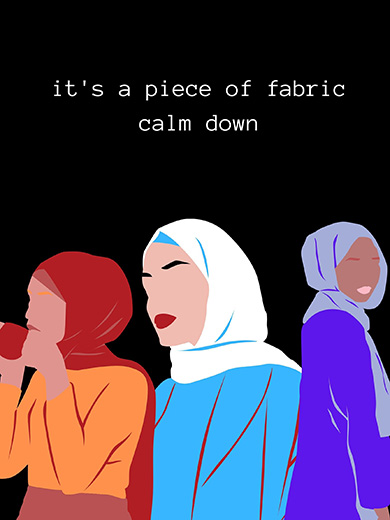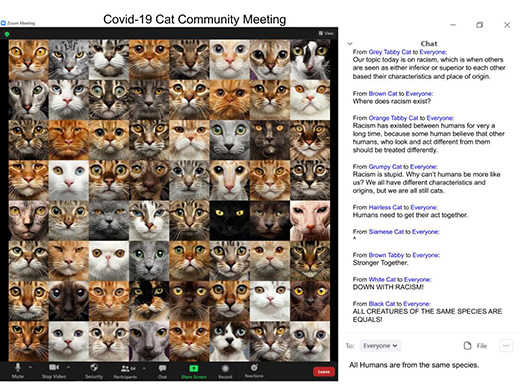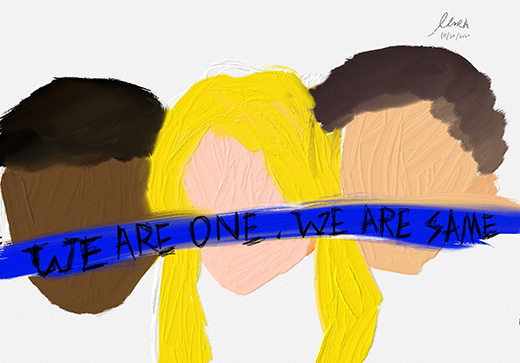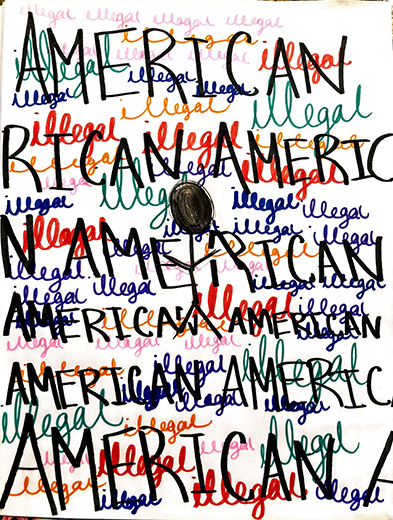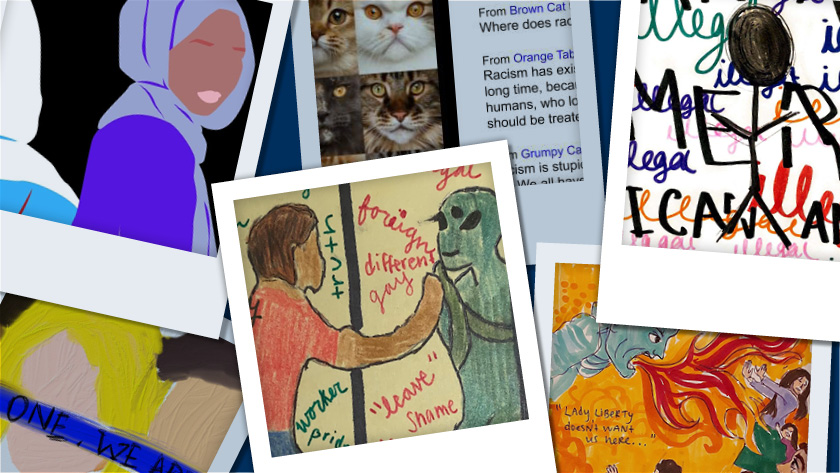
Students Reflect on Race, Identity and Social Injustice
The COVID-19 pandemic has been a challenging time for everyone. Amid health and safety concerns, we have wrestled with isolation and questions of community and belonging while grappling with the stark realities of racism, sexism, the mistreatment of immigrants and other issues of systemic injustice
Many of those same themes and issues are represented in Dear America: Notes of an Undocumented Citizen by Jose Antonio Vargas—the Fall 2020 First Year Common Reader.
After reading the memoir as part of their First Year Seminar course, more than 1,500 first year students participated in “Documented: A Virtual Introduction to the Library and Museums.” The program encouraged students to interact with primary sources, artwork and films related to Dear America; and to use resources from the Library, Museums and Press to research a social issue important to them.
The virtual program also provided a safe, welcoming and inclusive space for digital and artistic reflections on the heavy themes that are so relevant in the book and in our day-to-day lives.
Here, we highlight a few of those reflections and share the inspiration behind them. For more, visit the online exhibition, Documented: First-Year Students’ Reflections on the Common Reader.
Freshman Jill Herron grew up in a safe haven city for immigrants, where all were welcome. Citizenship wasn’t often something that crossed her mind. Dear America prompted her to reflect on the struggles of the immigrant community that so often go undiscussed and to challenge her definition of a “citizen” and what makes someone a contributing member of society.
“I was inspired to create this piece to highlight the way that people’s words can harm someone; to show how the things we hear slowly chip away and change the way we view ourselves … After being projected on repeatedly, it is common to start believing the things you hear others say about you. So, by being called illegal, receiving signs of disgust from ‘legal’ citizens, and sensing an overall feeling of not being welcome, these people begin to see and feel that way about themselves.”
“[Don’t] overlook the austerity of the alien in the mirror. I want to emphasize that the way some people treat undocumented citizens literally dehumanizes them and that is not okay … I want people to realize that on the other side of the mirror there is a human being, just like them, who is doing whatever they can to create a better life for themselves. Leaving your homeland is one of the hardest, if not the hardest, decisions anyone will ever have to make, and their citizenship does not make them any less human.”
—
During her senior year in high school, freshman Nadia Sheikh started wearing the hijab. With her digital reflection, she was inspired to create a simple but meaningful illustration that depicts Islamic Muslim women and how their hijabs are just coverings, not signs of oppression or terrorism.
“The hijab, overall, means to cover up, to be modest in your dress and actions. That rule applies to Muslim men and women. [I started wearing the hijab because] I did not want to be objectified because in this day and age that’s what it’s all about, sadly. And, it felt good to not follow those ‘standards.’ But of course, as the media puts it: the hijab is oppressing. When really, I think that the hijab helps me feel more like myself before I ever had started covering my hair. But no matter how many times Muslim women have to speak up for themselves, they are put down by slander and stereotypes. No one truly does their research and just creates their own assumptions. That assumption can lead to dangerous intentions.”
“Notice the three Hijabis at the bottom [of my artwork]. Look at the color, diversity, and see it for its beauty … I wear the hijab to represent my religion, to be modest, and to be myself. Covering my hair is not going to cause the end of the world.”
—
Freshman Makayla Randolph drew her inspiration from today’s main source of face-to-face communication—Zoom meetings—and the idea that cats are always up to something behind our backs.
“My piece represents the idea of how animals, such as cats, think that humans are very complicated … Humans base their friendships and relationships on the color of other humans around them, which allows for racism to exist in the human species, while cats don’t base their friendships and relationships on the color of the other cats around because all cats are part of the same species.”
“[When viewing the piece,] I don’t want others to miss the fact that not just cats, but all animals are smarter than humans when it comes to working together to survive as a species.”
—
Inspired by the changes resulting from the COVID-19 pandemic, freshman Haixin Cao created a piece that underscores the need to come together during a time when we’re all trying to process and cope with the physical pain of COVID-19, prevailing issues of social injustice and continued racial violence.
“The three people in the painting represent three races … This blue belt represents the mask, and means the difficult times we are now passing through. Moreover, this blue belt connects the fate of the three races together, which means that everyone is facing the same challenges. Everyone should unite the front to fight the coronavirus, instead of hurting each other.”
“There is no reason for any race to be treated differently, and when a virus chooses to descend on someone, it will not choose to take a detour because of his or her nationality and skin color. As I wrote on the painting, ‘We are one, we are same,’ in this difficult time. What we should do is not discrimination and violence, but unity and mutual help, so as to help us get through the difficulties faster.”
—
After reading Dear America, sophomore Olivia Blau was inspired to create a visual representation of identity for undocumented immigrants in America.
“To me, American is not just a nationality. It is a word that represents hope, opportunity, and is a form of identity. Many people are quick to label undocumented immigrants as ‘illegal’ without thinking how much weight that word holds.”
“Notice that I put ‘American’ on top of the word ‘illegal.’ These immigrants don’t view themselves as ‘aliens’ or ‘illegal,’ but as Americans, just like the people that were born here. Some people are lucky enough to be born in America, but others need to take matters into their own hands and become Americans in a different, less traditional way.”

